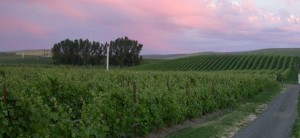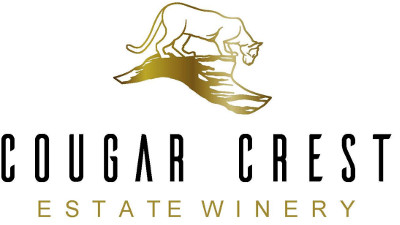Home Page › Vineyards › Cougar Hills Vineyards
Cougar Hills Vineyards

TOPOGRAPHY.
Cougar Hills Vineyard is a stone’s throw from the site of the original Seven Hills Vineyard planted more than 30 years ago, that began the Walla Walla legacy of quality vineyards. Tucked into the southwest corner of the Walla Walla AVA, as the name implies, there is a hill at Cougar Hills. The elevation averages 800 feet at the base and rises to 845 at the top of the hill. The slope of the hill faces north, which in the summertime is facing the sun. Having a hill in the vineyard promotes good air flow, especially when we are fighting frost.
VARIETALS.
We have planted several different varietals at Cougar Hills, with the countries of origin ranging from France to Spain and Portugal. The Bordeaux varietals we have planted are Merlot, Cabernet Sauvignon, Cabernet Franc, Malbec, and Petit Verdot. The Rhone varietals are Syrah and Viognier. Our Spanish varietals are Tempranillo and Grenache. The Portuguese varietals that we use in our port are Tinto Cão, Touriga Nacional, and Sousão. We grew our own Cabernet Sauvignon plants from cuttings off the original Seven Hills Vineyard. There is also a small block of Clone 99 Syrah that we grew from cuttings. This variety give our winemaker many options for blending and creating highly complex and balanced wines.
All of our vines are on self-rooted plants. Washington State is one of the few places in the world where this can be done without suffering phylloxera damage. Phylloxera is a louse (small bug) that lives in the ground and attaches itself to the roots, sucking its nutrients from the plant. Eventually the vine fails to thrive and in most places in the world has to be replaced with vines grafted to phylloxera resistant root-stock. In Washington, where a harsh winter occurs about every six years, we can re-grow our vines from the roots, instead of having to replant and start over. We may lose a crop for one year, but never for three years. Scientists are not sure why phylloxera doesn’t thrive here, but maybe our cold winters are a blessing in disguise!
SOILS.
The soil type here is Ritzville loam, mixed with layers of gravel and river rock. All of this vineyard was underwater during the “Bretz Floods”. Therefore it received silt loam from Ritzville and gravelly layers from each successive flood. In addition, a few feet below the surface, is a massive layer of river rock deposited eons ago by the rivers that poured out of the Blue Mountains. We found this river rock layer when we were installing our water storage pond. Digging 40-50 feet below the surface we could not find the bottom of this river rock. A layer of volcanic ash is also present about 3 feet below the surface and is a valuable source of nutrients for the vines. Geological experts say the ash came from Mount Mazama when it blew up and created Crater Lake. The Ritzville loam, gravel, river rock, and ash are essential to growing the different varietals we have planted at Cougar Hills Vineyard. The loam layer has good water and nutrient retention, while the gravel and river rock layers allow good drainage for the roots.
VITICULTURE.
Our vines are planted in rows aligned in a north-south orientation. This allows maximum sun exposure from the East as soon as the sun rises and all day long as the sun passes overhead and sets in the West. We have chosen to train our vines using vertical shoot positioning, which means that we grow two main trunks up from the ground close together, then train the top of each truck horizontally along a trellis wire. This horizontal portion is called the cordon. From the cordon grows vertical shoots from each node, hence the name. The grapes grow from these vertical shoots. We chose vertical shoot positioning as our training method for our vines because it allows us to control the canopy and the sun exposure we get throughout the day. It also allows air circulation to reduce humidity within the canopy which reduces the threat of mildew. The canopy also provides a dappled sunlight when the sun is overhead, during the hottest part of the day, preventing sunburned grapes. Recently research conducted on adding cross-arms to the canopy has shown that the surface area exposed to sunlight increases 30%. This is a huge advantage for ripening a crop and we have begun instituting this in our own vineyards. When we talk about “balancing the vine” we are referring to maintaining a large enough leaf area, the canopy, to feed and support the grape load. Too much canopy or not enough canopy and the energy generated by the vine is not creating good grapes for winemaking. Likewise, you need to carry a big enough grape load to use the energy being generated by the leaves or else that energy will be used by the plant to create a huge, overgrown canopy. Vertical shoot positioning is enhanced by using movable catch wires, to “catch” the shoots and hold them vertically above the cordon.
GROUND COVER AND IRRIGATION.
The ground cover between the vine rows is a grass selected for its slow growth and drought tolerance. Reducing the number of times per year that we have to mow the grass reduces soil compaction and provides a home for insects that might invade the vines if we didn’t have grass. When we do mow, we will mow alternating rows so that the insects will stay on the ground and move over to the unmowed row instead of invading the vines. By reducing the insecticides used we are able to maintain an active population of beneficial insects, creating an integrated pest management system.
Water management is a huge factor in controlling grape quality. Our average rainfall per year is 8-10 inches, most of which comes in the winter and spring. We are very fortunate to have a climate that is dry during the growing season. This allows us to determine how much water the vines get and when they get it. Once established, vines need very little water because they have such a deep root system. In our vineyards we have installed both overhead irrigation and drip irrigation. Most of the time we will use the drip irrigation to water the vines. Sometimes, due to the long periods of extreme heat that Walla Walla summers are known for, we will use the overhead irrigation to cool the vineyard off and irrigate the ground cover as well as the vines.
FROST CONTROL.
In addition to all of these practices that help us grow the best wine grapes possible, we need to protect our vines during seasons of heavy frost and freezing temperatures. Thus all of our vineyards are equipped with wind machines for frost control. These help mix the warmer air that is 70 feet above the ground with the colder air at ground level and can save the plants and buds from cold damage. Grapes have three frost seasons where temperature is critical. In the springtime we are protecting the young shoots and buds, in the fall we are protecting the foliage from early frosts that can kill the leaves that provide nutrition to ripen the grapes, and in the winter, dormant vines have to be protected from temperatures that dip below zero. Unfortunately for Dave, all frost seasons require being in the vineyard between midnight and 7 am to turn the machines on! But it is this diligence that means the difference having a grape crop or not.
The last two years Cougar Crest has invested in other frost fighting equipment. We now have a Big Green Fan, that, supplied with power from the PTO of a tractor, will pull air off the ground and blow it 300 feet in the air. This helps us keep cold air from settling and pooling in low areas that the wind machines don’t reach. Also, to augment the work of the wind machines, we invested in Big Blowers (from Sweden)that rotate, using heat from propane to circulate in a 5 acre circle. This heat is also spread around the vineyard by the wind machines. In the springtime, when nights are freezing but days are warm, we can also use irrigation water to add heat to the vineyard. As this water freezes on the vine, it creates a protective layer of ice that keeps the vine at 32 degrees. As water turns to ice it releases a small amount of heat that protects the plant tissue at the center of the ice. When the sun comes up in the morning the ice melts and the plant is good as new.
SUSTAINABILITY.
The ideal goal of farming is to manage the vineyards so that the land, water, and air quality are maintained at a pristine level for generations to come. To achieve this, we have instituted many farming methods that are low impact on the ecosystem. Our mower is also a mulcher and when we prune the vines or mow the ground cover, we are mulching the organic material so that it breaks down and increases the organic content of the soil. Instead of using herbicides, we have a French hoe that cuts through the roots of the weeds to keep the area under the vines weed free. Soil testing and petiole testing guide us in the decision to add fertilizers or nutrients to the soil, so that we are using them only when and if they are needed. The ground cover reduces airborne dust, reduces pesticide usage and provides a home to beneficial insects. Irrigation can be done using the method that best reduces water usage, putting water only where it is needed. By reducing the number of times a tractor is needed to mow, fertilize, rake, or spray we are also reducing soil compaction and air pollution. Our goal is to create a legacy so that this land is healthy and productive for future generations.










